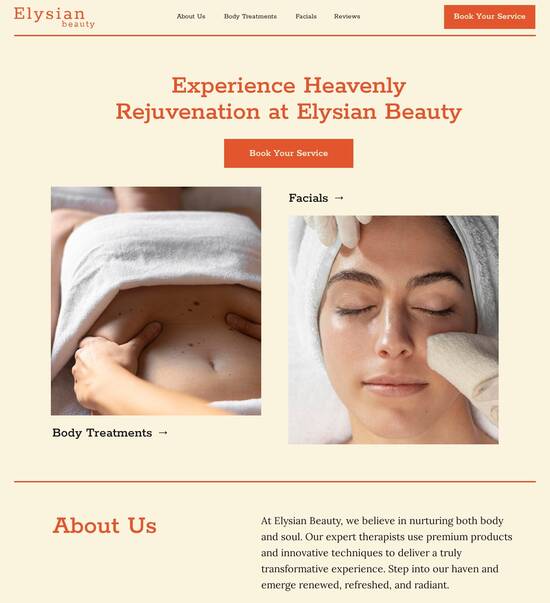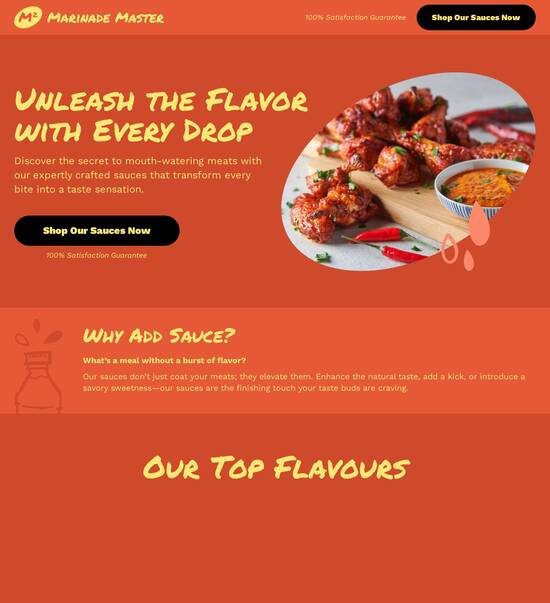
Web page template for Patient advocates
Use TemplateAbout template
Attract clients and showcase your skills with style using our landing page templates for Patient advocates. Let's convert those visitors into clients!
Recommended templates

Easy to build without coding
With the intuitive drag-and-drop builder, anyone on your team can create high-converting pages without any knowledge of code or design. Make enhancements to your landing page with custom widgets using Javascript, HTML/CSS, or third-party scripts.

Multiple layouts for any industry and goal
Select from 500+ landing page layouts built to boost conversions across industry-specific scenarios. Customize them by adjusting fonts, adding images, and generating on-brand content with the AI assistant. Quickly scale with Instablocks® and Global Blocks that you can save, reuse, and update globally.

Loads fast and looks polished on any device
Every template is responsive, which means they present professionally on any device and load blazingly fast with our Thor Render Engine. You can also power them up with Google AMP technology to deliver an unparalleled mobile experience and drive higher conversions.

Robust analytics & experimentation
Get real-time updates and reporting across all your devices, showing the number of visitors, conversions, cost-per-visitor, and cost-per-lead. Launch AI-powered experiments, run A/B tests, and use heatmaps to analyze user behavior, then optimize your landing page to maximize conversions.







Easy to build without coding
With the intuitive drag-and-drop builder, anyone on your team can create high-converting pages without any knowledge of code or design. Make enhancements to your landing page with custom widgets using Javascript, HTML/CSS, or third-party scripts.
Multiple layouts for any industry and goal
Select from 500+ landing page layouts built to boost conversions across industry-specific scenarios. Customize them by adjusting fonts, adding images, and generating on-brand content with the AI assistant. Quickly scale with Instablocks® and Global Blocks that you can save, reuse, and update globally.
Loads fast and looks polished on any device
Every template is responsive, which means they present professionally on any device and load blazingly fast with our Thor Render Engine.
Robust analytics & experimentation
Get real-time updates and reporting across all your devices, showing the number of visitors, conversions, cost-per-visitor, and cost-per-lead. Launch AI-powered experiments, run A/B tests, and use heatmaps to analyze user behavior, then optimize your landing page to maximize conversions.
All the features you need to build lead-generating landing pages
Explore more featuresLearn how to build top-performing landing pages for any goal
FAQs
Leading the way in building high-performing landing pages





Harnessing the power of Instapage for effective landing page optimization
Discover why Instapage is an essential tool for marketers looking to amplify their digital campaigns. With its robust capabilities, Instapage stands out as a leader in landing page and conversion rate optimization (CRO), enabling you to create high-converting pages that capture and nurture leads effectively.
Understanding landing page effectiveness
Effective landing pages are crucial for driving conversions and maximizing ROI. Instapage simplifies the process of creating such pages through its easy-to-use interface. By leveraging features like templates, you can create dedicated landing pages tailored to your audience’s needs and boost your campaign's performance.
- Pre-built Templates: Select from 100+ high-converting templates designed for various industries and goals.
- Customization Tools: Utilize drag-and-drop builders and extensive libraries to customize your pages effortlessly.
- Analytics Dashboards: Monitor page performance with detailed analytics to refine your strategy.
Creating a landing page with Instapage
To build your landing page, follow these straightforward steps to ensure you're set up for success:
- Choose a Template – Start by selecting a conversion-focused template that aligns with your campaign goals. Instapage offers designs for various niches, making it easy for any marketer to get started.
- Customize Content – Customize the template with relevant text, images, and calls to action (CTAs) that resonate with your target audience. Dynamic text replacement features allow for personalized experiences.
- Publish and Optimize – Launch your landing page and use Instapage's built-in A/B testing tools to optimize it for higher conversions by iterating based on real-time data.
The importance of optimization and personalization
Optimization is key to maintaining high conversion rates. Instapage provides powerful tools to help you analyze user behavior on your landing pages, which includes:
- Heatmaps: Understand where users are clicking and how they interact with your content.
- A/B Testing: Experiment with different versions of your landing page to find the best performing elements.
- Personalized Experiences: Use dynamic content features to tailor messages according to visitors’ profiles and behaviors.
By taking these steps, marketers can create effective landing pages that not only attract users but also convert them into loyal customers.
In conclusion, leveraging Instapage for your landing page strategy can significantly enhance your digital marketing efforts. The power of templates, optimization, and personalization positions you to outperform competitors and maximize your ROI.
Ready to transform your landing page strategy? Sign up for Instapage today and unlock the potential of your marketing campaigns!
People also ask about Web page template for Patient advocates
Web page template for patient advocates
Understanding the role of patient advocates in healthcare
Patient advocacy plays a pivotal role in healthcare by representing the interests and needs of patients. Patient advocates act as intermediaries between patients and the healthcare system, helping individuals navigate through the often convoluted processes associated with medical care. They ensure that patients are informed about their rights, treatment options, and potential outcomes, fostering an environment where patients can make empowered decisions regarding their health.
Advocates are essential in ensuring that patients' voices are heard in decision-making circles. Their presence enhances patient autonomy, allowing individuals to actively participate in their healthcare journey. This level of advocacy not only improves patient satisfaction but also contributes to better health outcomes by encouraging adherence to treatment plans and compliance with medical guidance.
Patient advocates help individuals understand complex medical jargon.
They coordinate between different healthcare providers to streamline care.
Advocates empower patients by educating them about their rights.
The challenges faced by patient advocates
Despite their crucial role, patient advocates encounter numerous challenges in their work. One significant challenge is navigating complex healthcare systems, which can often be overwhelming for both advocates and patients. The ever-changing policies and regulations can obscure clear communication and complicate the advocacy process.
Additionally, patient advocates must balance the needs of patients with institutional policies. This can potentially lead to conflicts of interest, where an advocate's efforts may be hindered by bureaucratic constraints. It requires a delicate balance to ensure that patient needs are prioritized while simultaneously adhering to institutional guidelines.
The importance of a dedicated web page template for patient advocates
A dedicated web page template for patient advocates can significantly enhance communication between advocates and patients. Effective communication is core to advocacy; therefore, a well-designed webpage can serve as a hub for clear messaging and increased accessibility. By providing easily navigable information, advocates can ensure that patients receive the guidance they require without unnecessary hurdles.
Moreover, the design allows for personalization, creating a tailored experience that addresses specific patient concerns. Personalizing content fosters a sense of trust and connection between the patient and the advocate, crucial in any advocacy effort.
Enhancing clarity and accessibility of key information.
Offering resources that cater to patients’ specific experiences.
Bridging gaps in understanding through interactive content.
Expanding outreach and building awareness
Utilizing a focused web page also serves as a powerful tool for expanding outreach and building awareness in the community. Engaging with the community through social media can create a buzz around advocacy initiatives and foster greater involvement. When advocates share compelling stories, successes, and important updates, they create a community that feels connected and motivated to participate.
Special events, such as community health fairs or celebrations, like Eid Mubarak, can be highlighted on the webpage. This not only promotes the events but also showcases the advocacy organization's commitment to cultural sensitivity, further attracting participation from diverse audiences.
Comprehensive features of the web page template
The web page template for patient advocates must include a range of comprehensive features to ensure optimal performance across various platforms. Firstly, size and layout flexibility are critical for adapting to different devices and screen sizes. In an age where more users access information through mobile devices, responsive design becomes essential for maintaining user engagement.
Moreover, responsive design ensures that patients can easily navigate resources and information regardless of their device type. This flexibility greatly enhances patient engagement by allowing users to interact with content seamlessly.
Adjustable layouts for both desktop and mobile views.
User-friendly design that accommodates all age groups.
Multiple viewing options to suit different preferences.
Accessibility options
Another critical aspect of the web page template is its accessibility options. Ensuring inclusivity for all visitors means utilizing tools such as screen readers and incorporating alt text for images. This is particularly vital for individuals with disabilities who rely on assistive technologies to access web content.
Beyond tools, adapting content for diverse patient populations by using straightforward language and incorporating multiple languages can further increase accessibility. This consideration allows advocates to reach a wider audience, ultimately improving the effectiveness of their communication.
Crafting engaging content for patient advocacy pages
Creating engaging content is essential for any patient advocacy page, as the tone and empathic messaging can greatly influence visitor interaction. It’s crucial to craft narratives that are grounded in understanding and empathy. By building content that connects with patients on an emotional level, advocates can create an authentic representation of patient experiences.
Moreover, storytelling can be a powerful tool in showcasing patient journeys. Using real stories, testimonials, and examples demonstrates the impact of advocacy work and allows patients to see themselves in those narratives. This connection can inspire hope and agency, motivating individuals to act and seek support.
Utilizing patient stories to demonstrate successful advocacy.
Developing content with a human touch that reflects shared experiences.
Incorporating guest blogs from patients or other advocates.
The importance of visuals
Visual content also plays a crucial role in enhancing the user experience. The right use of colors, images, and infographics can evoke specific emotions and help convey messages more effectively. For instance, calming colors can instill feelings of safety and trust, while eye-catching graphics can draw attention to important information.
Additionally, designing user-friendly tables and menus that reflect typical patient queries can facilitate easy navigation. A well-organized layout enables visitors to locate information quickly, making the advocacy process smoother for both patients and advocates alike.
Tailoring the experience based on place and occasion
Tailoring content to fit local health needs is another crucial element of a patient advocacy webpage. By integrating community health resources and local initiatives, advocates can create a more relevant and engaging experience for their audience. This localization not only enhances the sense of community but also empowers individuals to take charge of their health.
Highlighting local events allows the page to serve as a valuable resource for patients and families in the area. Events like health fairs or festivals can be prominently featured, offering patients opportunities to connect with others and gain knowledge about available resources.
Connecting with local hospitals and health organizations.
Promoting initiatives that address community health concerns.
Highlighting collaborative efforts to streamline patient services.
Celebrating milestones and special occasions
Additionally, recognizing and celebrating special occasions, such as Eid Mubarak, is a meaningful way to include diverse patient populations in advocacy efforts. Content that reflects cultural sensitivity strengthens the connection with the community and encourages participation in advocacy activities.
Promoting events tailored to celebrate or acknowledge these occasions can create a warm, welcoming atmosphere on the webpage, making it an inclusive space for everyone. It is also an opportunity to educate patients about health topics that are especially relevant around these celebrations.
Features that facilitate interaction and feedback
Facilitating interaction and feedback through the webpage improves the overall experience for users. Creating opportunities for customer engagement, such as allowing for patient testimonials and success stories, can enrich the site's content. When patients share their experiences, it not only validates the work of advocates but also encourages others to participate.
Encouraging visitors to share their ideas and feedback can lead to a more engaging and responsive advocacy effort. A feedback mechanism can foster a collaborative environment where patients feel valued and heard, strengthening the connection with the advocacy organization.
Incorporating a dedicated section for user-generated stories.
Utilizing surveys to gather patient input on various topics.
Ensuring visibility of feedback options to enhance participation.
Surprise gifts and incentives for participation
Offering surprise gifts and incentives can be an effective way of attracting attention and fostering loyalty among patients. Strategies such as exclusive giveaways or recognition programs can generate excitement and participation. When patients feel rewarded for their engagement, it reinforces their relationship with the advocacy organization.
Examples of effective incentives might include gift cards, discounts for health services, or even entries into larger raffles for health-related products. Each of these elements encourages patients to actively participate in advocacy efforts, creating a sense of community and belonging.
Metrics for evaluating page effectiveness
To truly understand how effective a webpage is, it's crucial to monitor user engagement metrics. Analyzing visitor traffic and interaction rates can reveal what content resonates with the audience and what needs improvement. Tools such as Google Analytics provide valuable insights into user behavior and help identify areas that may require further attention.
Furthermore, evaluating design choices through metrics allows advocates to understand how enhancements can improve user experience. Knowing which elements perform well can guide future design decisions, making the webpage even more effective.
Tracking page views and visit duration to assess engagement.
Measuring interaction rates on feedback forms and surveys.
Utilizing heatmaps to understand where users focus their attention.
Using feedback to continuously improve design
Incorporating visitor suggestions into webpage updates is paramount for continuous improvement. Patient advocates should regularly review feedback and adapt the site accordingly, ensuring it meets the changing needs of patients. This flexibility displays a commitment to responsiveness and care.
A/B testing different layouts and content strategies is also a recommended practice. By experimenting with various design elements and content, advocates can further customize the user experience to maximize engagement and effectiveness.
Building a social media buzz around patient advocacy
Integrating social media into the template of a patient advocacy webpage can significantly boost visibility. Encouraging the sharing of patient stories and events on platforms like Facebook, Twitter, and Instagram helps to spread awareness about the advocacy efforts. When advocates create shareable content and visuals, it encourages community members to engage and share their experiences, enhancing the organization’s reach.
Furthermore, utilizing targeted digital marketing strategies can maximize the impact of social media outreach. Deploying ads directed at specific communities can ensure messages resonate with the intended audience, driving more traffic to the advocacy page.
Creating visually appealing and shareable content tailored for social media.
Collaborating with local influencers to expand outreach.
Utilizing hashtags to connect with broader advocacy efforts.
Using digital marketing strategies
Digital marketing is an essential part of effectively advocating for patients. Deploying targeted ads creates awareness for specific campaigns and events, ensuring the advocacy organization reaches the right audiences. Additionally, crafting compelling campaigns around events or new content releases can generate excitement and engagement within the community.
These marketing strategies ensure that the advocacy efforts are visible and that there is a continuous relationship between the organization and the community, reinforcing the importance of patient advocacy throughout various channels.
Innovative ideas for future enhancements
As technology evolves, incorporating innovative elements into patient advocacy webpages can enhance user experience significantly. Implementing interactive features such as live chats with advocates can provide immediate support for patients seeking assistance. This real-time interaction allows advocates to address inquiries and concerns dynamically, fostering a more engaging atmosphere.
Additionally, using surveys can provide valuable insights into real-time patient feedback. These inputs can inform the continual evolution of advocacy efforts and ensure responsiveness to patient needs.
Implementing chatbots for 24/7 interaction on the website.
Real-time polls during events for immediate interaction.
Offering virtual office hours for advocates to connect with patients.
Virtual reality and augmented reality integration
Exploring the potential for immersive experiences through virtual reality (VR) and augmented reality (AR) can elevate patient advocacy to new heights. These technologies allow patients to experience various scenarios that can help in their understanding of healthcare processes. For instance, VR can create simulations that prepare patients for upcoming treatments, while AR can provide real-time information through smartphone applications.
By utilizing technology in such creative ways, patient advocates can make healthcare feel more approachable, reducing anxiety around medical experiences. The goal is to bring awareness and education to life while ensuring that support resources are readily accessible.
Final thoughts on transforming patient advocacy through web design
The evolution of digital advocacy through personalized and well-designed web pages provides new opportunities for meaningful connections. It is crucial for patient advocates to leverage technology to foster deeper relationships with patients and communities. As healthcare becomes increasingly technology-driven, embracing these changes will enrich the advocacy landscape.
Anticipating the next generation of patient advocate websites involves staying abreast of trends and technologies that can enhance the patient experience. Preparing for the changing landscape of healthcare advocacy ensures that patient needs remain at the forefront of organizational efforts.
Identifying trends like telehealth to inform website features.
Preparing for advancements in accessibility technology.
Enhancing user experience based on emerging digital behaviors.
Ready to skyrocket conversions?
Supercharge your ad campaigns with high-performing landing pages
Get started














